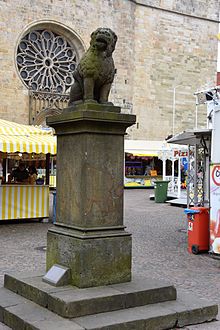Lion poodle
The lion poodle is a statue in front of St. Peter's Cathedral in the Lower Saxony city of Osnabrück . It shows a lion sitting on an oversized pedestal, which looks like a poodle. Badly damaged by the weather, a replica has been standing on the base since 1929, created by the sculptor Lukas Memken (1860–1934). The earlier stone is in the city's cultural history museum, although this was probably not the original either.
background
Possibly the statue is a legal antiquity - a sign of jurisdiction, as it was also used on seals. It was given to the city by Duke Heinrich the Lion . The lion poodle looks similar to the Brunswick lion , although no connections could be established.
When the monument was given the name lion poodle is unknown and is not answered by the pictorial legend, which cannot have happened because poodle breeding in Germany only began in the 19th century. This designation is never used in medieval documents; the monument is always called The Stone Lion or Lion's Arch . It was first mentioned in 1331.
Location and age
The monument stands opposite the two-towered west facade of the cathedral, near the south side of the episcopal chancellery and exactly in the northwest corner of the cathedral courtyard .
In older times, this was the main entrance to the heavily fortified Domburg, where the Gogericht is said to have been, which was first mentioned in 1171. When the strong walls of the Domburg were abandoned because the city fortifications included the cathedral area, the Martinskapelle was built where the office is today. It is first mentioned in historical sources in 1217. At this time the lion statue is not mentioned, but for the first time in 1331. Whether the monument was closely connected to the Gogericht, perhaps even its landmark, whether it was on the bailiwick and the jurisdiction of Henry the Lion (who owned the bailiwick in 1170) pointed out, his exact age remains uncertain. However, it can be assumed that the statue that was replaced by a copy in 1929 was not the original either and that the lion poodle had other predecessors. Stone sculptures exposed to wind and rain only survive a few centuries.
legend
According to popular legend , Charlemagne was angry with the people of Osnabrück when he learned that the citizens had re-established contact with Wittekind and the pagan Saxons during his absence . Karl took the oath that he would chastise the city by cutting off the head of the first living being that came towards him when he moved into Osnabrück.
When Karl moved into the city, only his sister, who was married to a Christian Saxon, dared to confront him with the intention of asking for mercy for the citizens. Karl saw her coming and pleaded to heaven that he might get him out of this terrible situation. Indeed, his sister's favorite dog, a poodle , suddenly jumped up and licked the king's hand. Karl killed him and thus fulfilled his vow without killing anyone. The grateful citizens had the picture of the dog carved in stone and set up in the cathedral courtyard. They called him the lion poodle.
Web links
- Monument "The Lion Poodle " in front of the cathedral on osnabrueck.de with a podcast of the legend
Individual evidence
- ↑ Lukas Memken on chronosroma.eu ( page no longer available , search in web archives ) Info: The link was automatically marked as defective. Please check the link according to the instructions and then remove this notice.
- ^ A b Hermann Poppe-Marquard : The lion poodle, an Osnabrück landmark. In: Osnabrücker Land. Pfotenhauer, 1982, ISSN 0171-2136 , p. 20 ff.
- ^ History of the Hochstift Osnabrück up to the year 1508. Volume 1, p. 203.
Coordinates: 52 ° 16 ′ 39.76 " N , 8 ° 2 ′ 37.25" E

